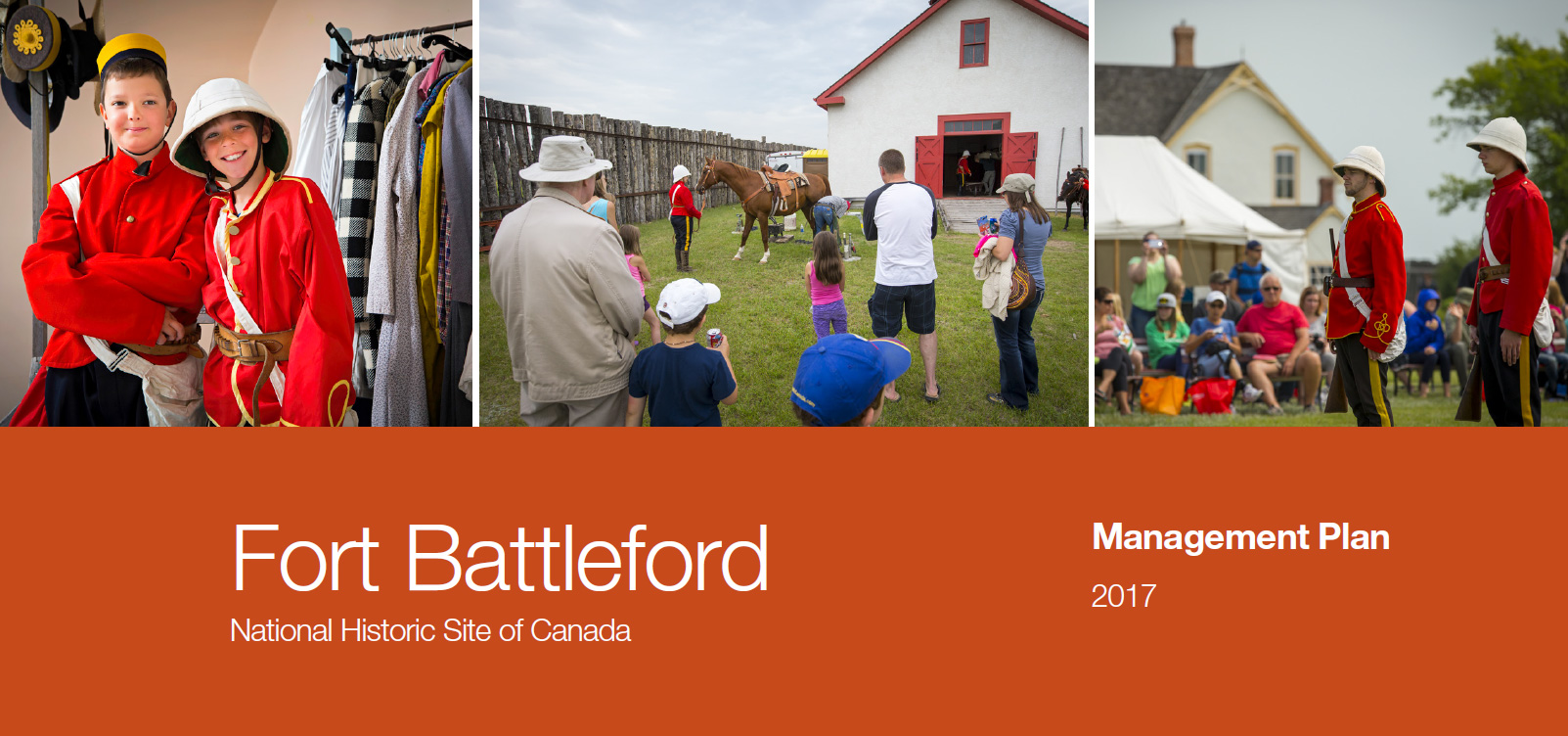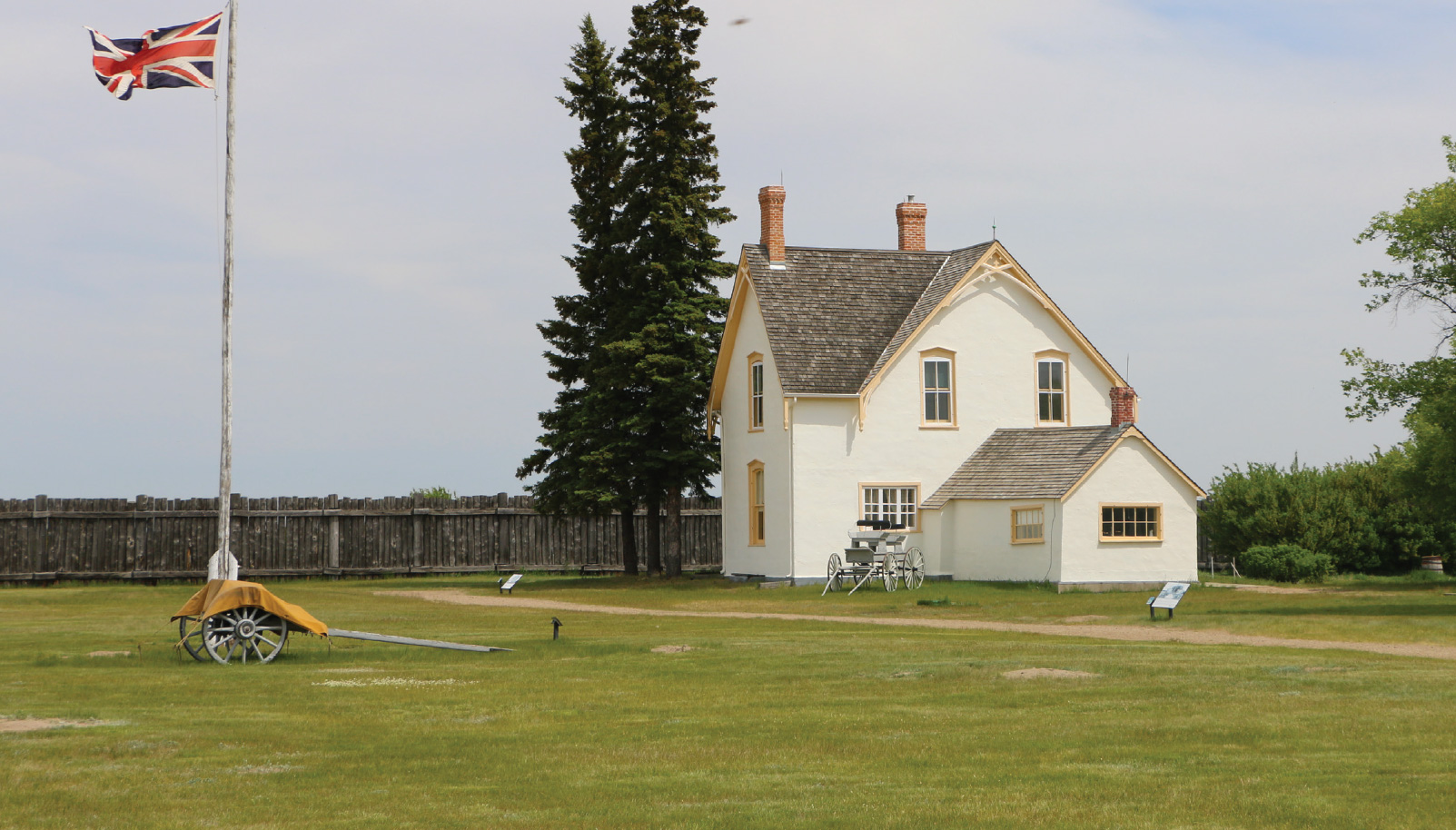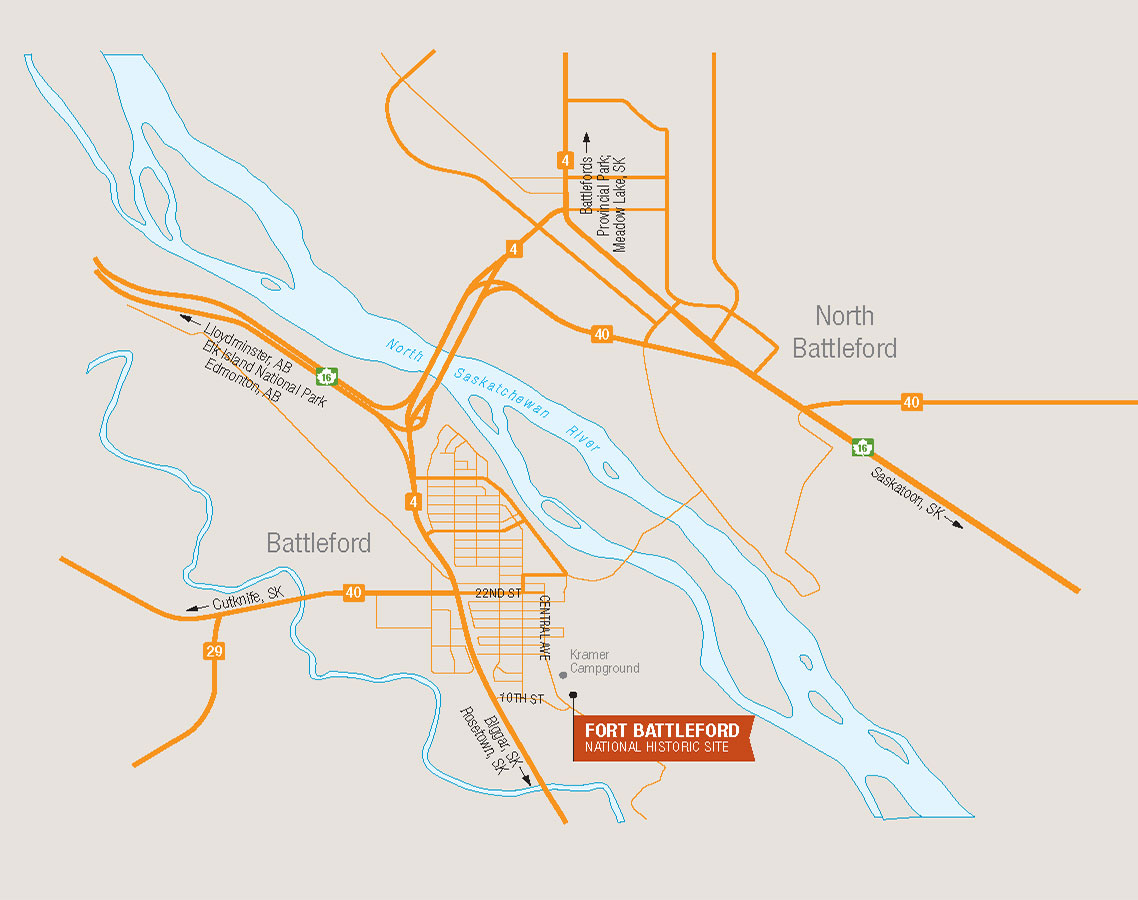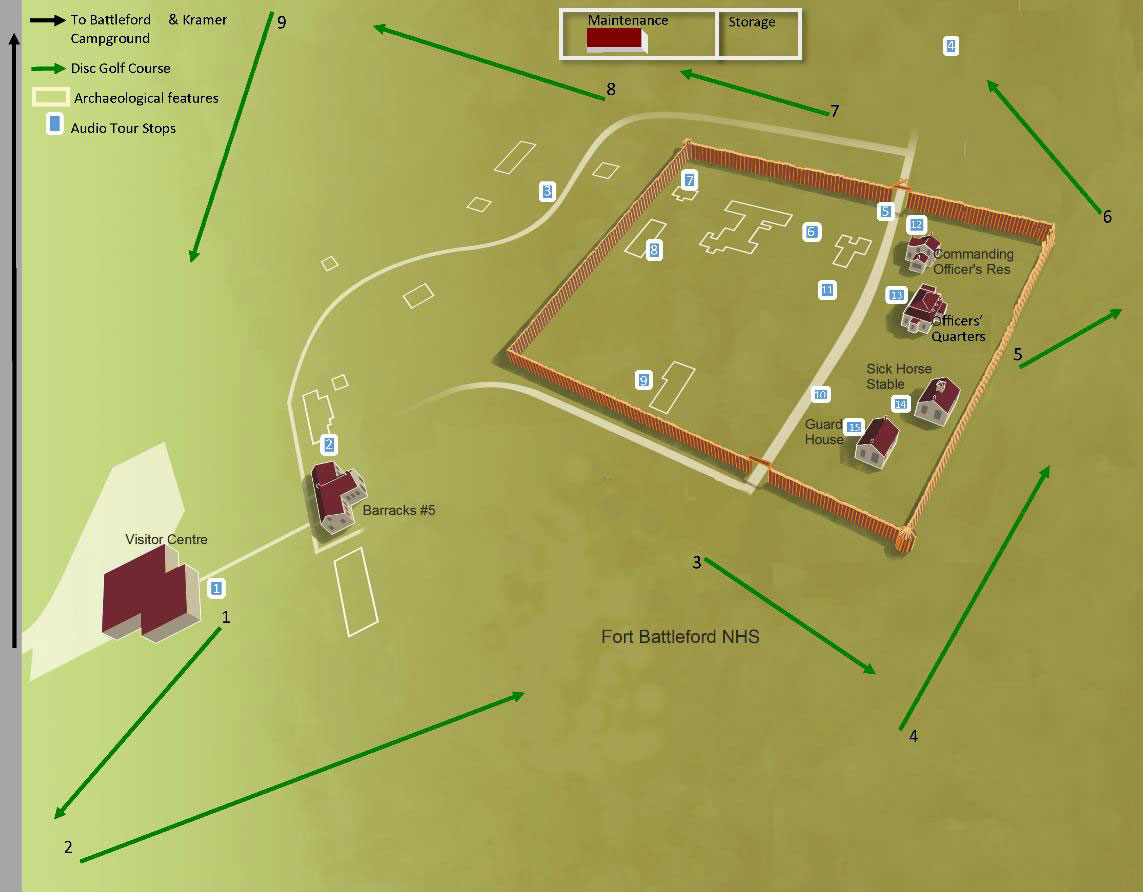Fort Battleford National Historic Site of Canada Management Plan 2017
Fort Battleford National Historic Site
Table of contents


© Her Majesty the Queen in Right of Canada, represented by the Chief Executive Officer of Parks Canada, 2017.
Cette publication est aussi disponible en français.
National Library of Canada cataloguing in publication data:
- Parks Canada
- Fort Battleford National Historic Site of Canada Management Plan 2017
Issued also in French under the title:
Plan directeur du lieu historique national du Canada du Fort-Battleford 2017
Available also on the Internet
- Catalogue No.: R64-284/2016E-PDF
- ISBN 978-1-100-21980-6
For more information about the management plan or about Fort Battleford National Historic Site:
P.O. Box 70
Battleford, SK S0M 0E0
Canada
Front Cover Image Credits
Top from left to right: Greg Huszar, bottom: Parks Canada
Foreword

Canada’s national parks, national historic sites and national marine conservation areas belong to all Canadians and offer truly Canadian experiences.
These special places make up one of the finest and most extensive systems of protected natural and cultural heritage areas in the world.
The Government is committed to preserving our natural and cultural heritage, expanding the system of protected places and contributing to the recovery of species-at-risk. At the same time, we must continue to offer new and innovative visitor and outreach programs and activities so that more Canadians can experience Parks Canada places and learn about our environment, history and culture.
This new management plan for Fort Battleford National Historic Site of Canada supports this vision.
Management plans are developed through extensive consultation and input from various people and organizations, including Indigenous Peoples, local and regional residents, visitors and the dedicated team at Parks Canada.
National parks, national historic sites and national marine conservation areas are a priority for the Government of Canada.
I would like to thank everyone who contributed to this plan for their commitment and spirit of co-operation.
As the Minister responsible for Parks Canada, I applaud this collaborative effort and I am pleased to approve the Fort Battleford National Historic Site of Canada Management Plan.
Original signed by
Recommendations
Recommended and original signed by
Daniel Watson
Chief Executive Officer
Parks Canada
Adriana Bacheschi
A/Field Unit Superintendent
Saskatchewan South Field Unit
Parks Canada
Executive Summary
Fort Battleford National Historic Site (NHS) is located in the Town of Battleford, approximately 150 kilometres northwest of Saskatoon. Established in 1876 by the North West Mounted Police to create a Canadian presence in the North-West Territories, the site was designated a national historic site in 1923.
This management plan replaces the 2007 management plan for Fort Battleford NHS which provided management direction for the heritage resource protection, heritage presentation, environmental stewardship, public involvement and partnerships. Since 2007, Fort Battleford NHS has continued ongoing work regarding the protection of cultural resources. Asbestos abatement was also completed in Barracks 5. Contemporary buildings have been removed from the historic grounds, contributing to the restoration of the sense of historic place to the site. Special events such as Halloween Haunted Fort, Canada Day Festivities and Fort Fest have grown over the last several years, and visitor experience opportunities have been expanded to include disc golf and audio tours. Partners and stakeholders have contributed to the success of the site, with new partnerships with Indigenous groups seen as integral to the success of the management of Fort Battleford NHS.
In the new management plan, two key strategies are proposed to guide management activities for Fort Battleford NHS over the next 10 years. Partnerships, along with offering a quality and diversified visitor experience, are central for these strategies, and will be integral to achieving the vision for the site
Key strategy 1:
Local and regional visitor awareness of and participation in Fort Battleford NHS as a community hub will increase and lead to increased visitation.
This strategy builds on increasing the opportunities for cultural, family and outdoor enjoyment at Fort Battleford NHS. The strategy is developed around the site being considered by surrounding communities as an important gathering place. It also foresees an increase in awareness of the site’s existence and expansion of quality experiences that visitors can enjoy at the site.
The strategy aims to achieve the following:
- More Canadians are visiting the site.
- Visitors are enjoying a high quality, enhanced and diverse experience in an authentic setting.
- Awareness of the site has increased.
Key strategy 2:
Visitors will enjoy a diversified experience enhanced by partnerships with people and groups who value the site.
Partners from surrounding communities and Indigenous partners are at the forefront of this second strategy. This strategy is built on existing and new partnerships that will contribute to enrich and broaden the visitor experience offer at the site including encouraging visitors to return to Fort Battleford NHS.
This second strategy aims to achieve the following:
- Visitors enjoy a variety of activities and programming.
- Meaningful relationships with Indigenous partners have been established and opportunities for increasing their engagement have been identified.
1.0 Introduction
Parks Canada manages one of the finest and most extensive systems of protected natural and historic places in the world. The Agency’s mandate is to protect and present these places for the benefit and enjoyment of current and future generations. Future-oriented, strategic management of each national park, national marine conservation area, heritage canal and those national historic sites administered by Parks Canada supports the Agency’s vision:
Canada’s treasured natural and historic places will be a living legacy, connecting hearts and minds to a stronger, deeper understanding of the very essence of Canada.
The Parks Canada Agency Act requires Parks Canada to prepare a management plan for national historic sites administered by the Agency. The Fort Battleford National Historic Site of Canada Management Plan, once approved by the Minister responsible for Parks Canada and tabled in Parliament, ensures Parks Canada’s accountability to Canadians, outlining how historic site management will achieve measurable results in support of the Agency’s mandate.
Indigenous peoples and Canadians were involved in the preparation of the management plan, helping to shape the future direction of the national historic site. The plan sets clear, strategic direction for the management and operation of Fort Battleford NHS by articulating a vision, key strategies and objectives. Parks Canada will report annually on progress made toward achieving the plan objectives and will review the plan every ten years or sooner if required.
This plan is not an end in and of itself. Parks Canada will maintain an open dialogue on the implementation of the management plan, to ensure that it remains relevant and meaningful. The plan will serve as the focus for ongoing engagement on the management of Fort Battleford NHS in years to come.
2.0 Significance of Fort Battleford National Historic Site
Fort Battleford was established in 1876 by the North West Mounted Police to create a Canadian Government presence in the North-West Territories. The site was designated a national historic site in 1923. The site was designated for its association with the North West Mounted Police and for the important role it played during the armed conflict of 1885 when it served as a refuge for area residents who feared a general outbreak of violence, and as a base of military operations by the Canadian militia sent to quell the unrest in the Territories. The post was closed in 1924, and in 1951, the site was turned over to Parks Canada to be administered as a national historic site.
The site is 22.8 hectares with the remaining five historic buildings dating from 1876 to 1898. A reconstructed palisade surrounds some archaeological features and four buildings including the Commanding Officer’s Residence (a ‘Classified’ Federal Heritage Building), Officers’ Quarters, Sick Horse Stable, and the Guard House (which are ‘Recognized’ Federal Heritage Buildings). Barracks No. 5, which houses interpretive displays, is also a ‘Recognized’ Federal Heritage Building, and is located outside the existing palisade along with many other archaeological features and historic trails.
In close proximity to Fort Battleford are other sites, not owned or administered by Parks Canada, that are relevant to the history of Fort Battleford. These include the 1885 mass grave burial site of eight First Nations men who were executed for their involvement in the 1885 armed conflict, the North West Mounted Police cemetery, trenches built by Colonel Otter’s forces, the site of Old Government House and the historic trails around Fort Battleford.
3.0 Planning Context
Planning for the future of a national historic site must take into consideration the administrative and legal context of the area, the state of the site, and trends that will affect the site in the years to come. The following were some of the considerations that informed the development of this draft management plan.
Legal and Operational Context:
The site is open to the public from mid-May until the beginning of September. Visitors can explore life at Fort Battleford in the 1800s while enjoying a self-guided adventure via an audio tour. Visitors and families can also enjoy a day at the Fort during special events such as Fort Fest or the Halloween Haunted Fort, or play a round of disc golf. The site has the capacity to host large scale events and accommodate approximately 8,000 to 10,000 visitors. The site can also accommodate parking on Parks Canada property and on the Town of Battleford property across the road. For special events, Fort Battleford NHS has the potential to attract visitors from a radius of approximately a two-hour drive, which would include the Town of Battleford (population: 4,065˟), the City of North Battleford (population: 13,888), Saskatoon (population: 222,189*), Prince Albert (population: 42,673˟) and Lloydminster (population: 12,766˟).
The site is subject to the Historic Sites and Monuments Act and the National Historic Sites of Canada Order and the review of the management plan is required every 10 years.
The current Fort Battleford management plan dates back to 2007. The assessment of the 2007 plan concluded that a majority of the objectives and actions have been implemented and a new plan was required. Since the last plan, Fort Battleford became a self-directed site (2013). This move to self-guided tours included the reduction of staff and a shortened operational season and hours. It changed the format of how the site was operated. During the last management plan period, a new Visitor Centre was constructed. The Town of Battleford contributed financially to the Battleford Room in the new Visitor Centre and an agreement is in place with the Town to manage this space.
Site Context:
Cultural Resources:
Canadians have a strong sense of connection through meaningful experiences to their national parks, national historic sites, and national marine conservation areas and these protected places are enjoyed in ways that leave them unimpaired for present and future generations.
Visitation:
The site welcomes an average of 5,000 visitors each year. The site has seen a decline in visitation over the last several years. The decline can be attributed to different factors, including decreasing school visits, decreasing attendance at summer camps, and lack of awareness of the site in local and regional communities.
Partners/Stakeholders/Support:
Fort Battleford has a very strong volunteer program; Fort Fest and Halloween Haunted Fort have a large volunteer base who return annually. Previously, the Friends of Fort Battleford, through an agreement, occupied an office in the Visitor Center, and provided a gift shop and concession within the Visitor Centre. The group also provided additional support for special events and programming. In 2016, the group ceased operation. There is good collaboration with the Town of Battleford and Battle River Settlement on an ongoing basis. However, there is a need for additional stakeholder support, community engagement and strengthened partnerships to diversify the activities and programming on site.
Indigenous Relations:
There is a strong desire to continue to pursue engagement opportunities with Indigenous partners. Previous partnerships that were once strong, such as that with the Poundmaker Interpretive Centre, have weakened over the last several years with the closure of that facility. Fort Battleford will continue to pursue engagement opportunities with Indigenous partners. Recent collaboration with the Bresaylor Métis community has brought a new aspect of the Indigenous story to the site. Work continues on an ongoing basis with a variety of Indigenous partners and organizations, including the Gabriel Dumont Institute, Wanuskewin Heritage Park, and members of the Poundmaker First Nation. Fort Battleford would welcome new partnerships as opportunities arise.
Map 1: Regional Setting

Map 2: Fort Battleford National Historic Site

4.0 Vision
Looking ahead 15 to 20 years, Fort Battleford National Historic Site (NHS) continues to tell the story of its importance in establishing the Canadian government on the Prairies and its role in the events of 1885. As visitors explore the site, they feel a connection with its history, and the larger national narrative that comprises the network of historic sites across the country. Visitors discover the meaningful Indigenous presence related to the site. That enriched visitor experience is achieved through the significant involvement and engagement of Indigenous partners. The good condition of the historic buildings and archeological features takes visitors back through time to the 19th century, contributing to an authentic visitor experience.
As an increasing number of visitors come to the site, they can also enjoy special activities and large scale events. The close involvement of partners contributes to establishing Fort Battleford NHS as an important gathering place in the region. Visitors, enchanted by the wide range of experiences and events offered, regularly return to this animated and vibrant site.
By reaching out to the residents of the surrounding communities, the regional support and engagement has brought a new energy to the site. Bringing together family and friends, Fort Battleford is considered a new regional community hub. It is a place to celebrate important regional and local events, along with nationally significant milestones, within a setting that captures the national importance of the site to the history of Canada.
5.0 Key Strategies
Fort Battleford NHS’s planning priorities are encompassed in two distinct strategies which aim to implement the long term vision:
- Local and regional visitors’ awareness of and participation in Fort Battleford NHS as a community hub will increase, and lead to increased visitation.
- Visitors will enjoy a diversified experience enhanced by partnerships with people and groups who value the site.
The key strategies outline the broad management approach. Each strategy features associated objectives (short and long term) and targets. Targets are meant to measure objectives and therefore define when an objective is achieved over the management plan implementation period.
Key strategy 1:
Local and regional visitors’ awareness of Fort Battleford NHS as a community hub will increase.
Visitors currently have a wide range of opportunities for cultural, family, and outdoor enjoyment. Leisure information is accessible to Canadians and promoted through various social media. The result foreseen by this strategy is that surrounding communities will consider Fort Battleford NHS as an important gathering place and that local and regional visitors come to the site in greater numbers. The strategy also seeks to increase local and regional visitors’ awareness of the site’s existence and the quality experiences that visitors can enjoy in their journey through Fort Battleford NHS.
Objective 1.1
More Canadians are visiting Fort Battleford National Historic Site.
Targets:
- By 2026, visitation has reached 6,095 (i.e., representing an annual averageincrease of 2% base on the 2014 visitation).
Objective 1.2
Visitors enjoy a high quality, enhanced and diverse experience in an authentic setting.
Targets:
- Within ten years, at least 90% of visitors enjoyed their visit.
- Within ten years, 90% of visitors are satisfied and/or very satisfied with their overall visit and the availability of activities on the site.
- Over the course of the next ten years, the cultural resources and assets continue to be in fair to good condition.
Objective 1.3
Awareness of the site by local and regional residents, including a diverse group of visitors, has increased.
Targets:
- By 2021, visits to the Fort Battleford NHS webpage has increased by 10%compared to 2014 current levels.
- On an annual basis, proactive social media and/or new collaborative mediaopportunities (e.g. partner websites) that connect with regional residents(including diverse group types of visitors) feature Fort Battleford NHScontent.
- By 2018, Fort Battleford NHS social media hits have increased by 10%compared to 2014.
Key strategy 2:
Visitors will enjoy a diversified experience enhanced by partnerships with people and groups who value the site.
Partners from surrounding communities and Indigenous partners will be at the forefront of this strategy, focused on the intended result of building and maintaining strong partnerships. Visitors will experience an enriched and broader offer and be encouraged to return, as additional opportunities for existing and new partners will be pursued (such as Friends of Fort Battleford, Town of Battleford, City of North Battleford, local First Nations, Métis communities, RCMP, etc.) to use the site for events and special activities and to collaborate with Parks Canada. Working together and having more partner involvement can help ensure that the partners’ values, beliefs and expectations are reflected on site, and can foster support for the continued protection of the site.
Objective 2.1
Visitors enjoy a more diversified experience featuring a variety of activities and programming as a result of an increase in strong partnerships.
Targets:
- On an annual basis, at least 2 events and/or programs are taking place at Fort Battleford NHS in conjunction with partners and/or volunteers.
- Within five years the number of volunteer hours through the various site opportunities (e.g., activities, programming, maintenance, etc.) has increased by 2%.
Objective 2.2
Work with new and existing Indigenous partners to establish meaningful relationships and identify opportunities for increasing their engagement.
Targets:
- Within three years, regular ongoing dialogue with various Indigenous partners is established.
- Building upon the new dialogue, the essence of the Indigenous relationships and engagement has been identified and work has begun toward achieving identified outcomes.
6.0 Summary of Strategic Environmental Assessment
Parks Canada is responsible for assessing and mitigating the impacts of management actions on ecosystems and on cultural resources. The Cabinet Directive on the Environmental Assessment of Policy, Plan and Program Proposals prepared by the Canadian Environmental Assessment Agency, requires a strategic environmental assessment of all plans and policy submitted to the federal Cabinet or to a Minister for approval deemed to have important positive or negative environmental effects.
A strategic environmental assessment was undertaken on this management plan, and the management direction found within has been adjusted to respond to findings. The following is a summary of the environmental assessment:
- The strategic environmental assessment evaluated the potential for effects on natural and cultural resources and visitor experience objectives.
- The key strategies, objectives, and targets identified in the management plan are oriented at achieving positive outcomes.
- Potential negative effects, including cumulative effects, on natural, cultural and visitor experience resources are expected to be minimal.
- Project-level impact assessments will address potential negative effects from individually-proposed projects and activities at the site.
- The Strategic Environmental Assessment concluded that the Fort Battleford National Historic Site of Canada Management Plan will have several positive effects on cultural resources and visitor experiences and is not likely to contribute to important negative effects.
Related links
- Date modified :